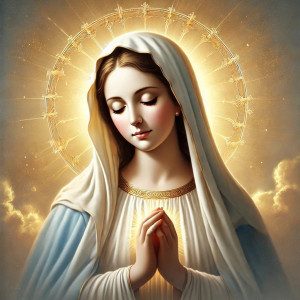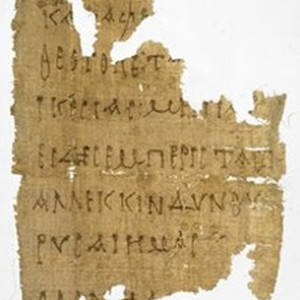Catholics pray the Hail Mary as an expression of devotion to the Virgin Mary, mother of Jesus Christ, and as a way to seek her intercession with God. The prayer is one of the most well-known in Catholic tradition and is deeply rooted in the faith and lives of many Christians around the world. Composed of two main parts, the Hail Mary reflects essential aspects of Mary's role in the history of salvation and her spiritual importance for the faithful.
The first part of the prayer, "Hail Mary, full of grace, the Lord is with thee", refers to the angel Gabriel's greeting to Mary during the Annunciation, a moment described in the Gospel of Luke (1:28). In this passage, Gabriel greets Mary as "full of grace", indicating the special grace of God that she received and that prepared her for her role as the Mother of the Savior. This divine greeting reflects God's unique favor upon Mary and recognizes her as someone chosen for an extraordinary purpose—to carry and give birth to Jesus, the Son of God. Thus, the first part of the Hail Mary honors Mary for her special grace and for her acceptance of her role in the history of salvation.
The second part of the prayer, "Blessed art thou among women, and blessed is the fruit of thy womb, Jesus", is taken from Elizabeth's greeting to Mary, also recounted in the Gospel of Luke (1:42). When visiting her cousin Elizabeth, Mary is blessed and recognized for carrying the Savior in her womb. This blessing highlights Mary's role as the Mother of God and confirms the recognition of her special role not only by Elizabeth but also by the faith community, which sees Mary as "blessed among women" and a model of obedience and faith.
The prayer continues with a supplication: "Holy Mary, Mother of God, pray for us sinners, now and at the hour of our death". In this request, Catholics recognize Mary as an intercessor who brings their intentions to Jesus. Although Catholics do not worship Mary, they believe that, as the spiritual mother of all the faithful, she has a special role in interceding with her Son. Jesus, dying on the cross, entrusted Mary as a mother to Christians in the person of the apostle John (John 19:26-27). This passage is seen as the origin of understanding Mary as the mother of all Christ's followers, who can approach her seeking comfort, help, and spiritual protection.
Moreover, praying the Hail Mary is also a way for Catholics to meditate on the mysteries of Christ's life and to strengthen the communion of saints, the spiritual union between all members of the Church, both living and those already in the presence of God. This concept of intercession is a practice of humility and faith, where the faithful seek Mary's help to grow in their Christian journey, always ultimately directing their devotion to God through Jesus Christ.
Praying the Hail Mary, especially in the context of the Rosary, allows Catholics to contemplate the life of Christ and the mysteries of faith, promoting an experience of meditation and spiritual renewal. This practice is a way to reinforce the bond between the faithful and their spiritual Mother, seeking her help to face life's challenges and attain eternal life.
Besides the biblical passages, there are historical records that evidence the veneration and prayer to the Virgin Mary since the early centuries of Christianity. One of the earliest known documents containing a Marian prayer is the "Sub tuum praesidium" (Under your protection), dating approximately from the 3rd century. This ancient Christian prayer reveals the faithful's trust in Mary's protection and intercession, stating: “Under your protection we seek refuge, Holy Mother of God; do not despise our petitions in our necessities, but deliver us always from all dangers, O glorious and blessed Virgin”.
The presence of this prayer in Christian practice since such ancient times evidences Mary's role as intercessor and spiritual mother since the earliest days of the Church. This document shows that, long before the Hail Mary prayer was structured as we know it today, there was already a practice of seeking Mary's intercession and recognizing her special role in the lives of Christians. This reflects a continuity in the Church's tradition, where devotion to Mary is rooted in the faith and trust that the faithful have always placed in her.
The Hail Mary prayer, therefore, is a continuation of this primitive veneration, deepening the spiritual bond of the faithful with Mary. She is seen as the mother who protects, guides, and intercedes—a role that was already recognized in the early centuries and that has been solidified throughout the history of the Church.

The Greeting of the Angel Gabriel
The first part of the Hail Mary comes from the angel Gabriel's greeting: "Hail, full of grace" (Luke 1:28), honoring Mary as God's chosen one. She is called "full of grace", prepared to be the Mother of the Savior.

Mary's Maternal Intercession
In the second part, "Holy Mary, Mother of God, pray for us", Catholics ask for Mary's intercession, recognizing her as a spiritual mother, trusting in her prayer to bring us closer to Christ and His love.

The Hail Mary in the Context of Tradition and History
Devotion to Mary is ancient in the Church. The "Sub tuum praesidium" (3rd century) is one of the earliest Marian prayers, reflecting Christians' trust in Mary's protection, which continues today in the Hail Mary prayer.
-
Luke 1:28: “Hail, full of grace, the Lord is with you.”
-
Luke 1:42: “Blessed are you among women, and blessed is the fruit of your womb.”
-
John 19:26-27: “Woman, behold your son… Behold your mother.”
While every effort is made to ensure accuracy and conformity with the teachings of the Catholic Church, we acknowledge that errors in interpretation or presentation may occur. If you identify any answer or content that is not in line with the official teachings of the Church, we kindly ask you to inform us. We are committed to reviewing and promptly correcting any errors that are identified.
We understand that fidelity to the Church’s doctrine is fundamental, and for this reason, we value users' collaboration in maintaining the integrity of the content presented.
We thank you for your understanding and commitment to the Catholic faith.







